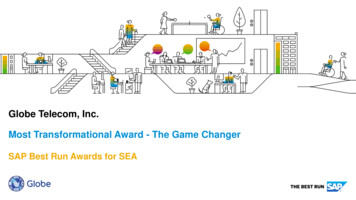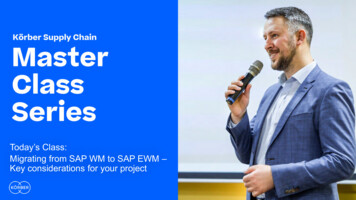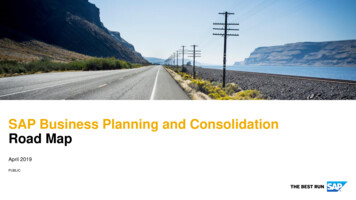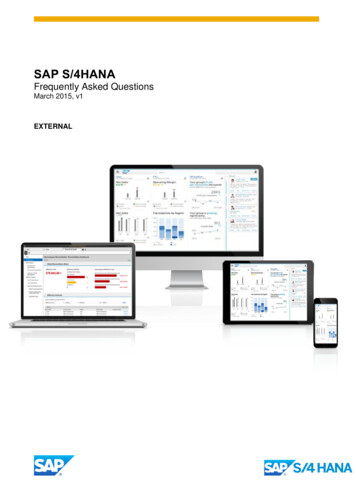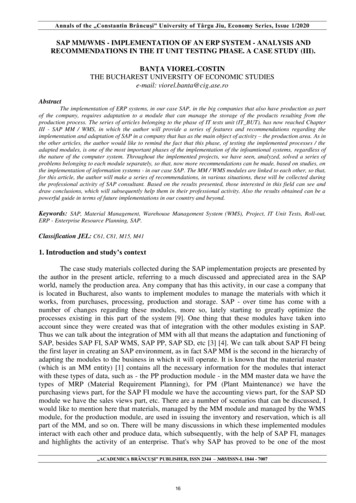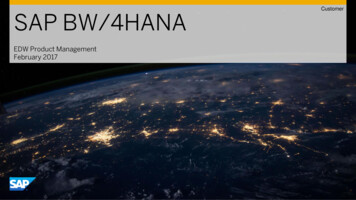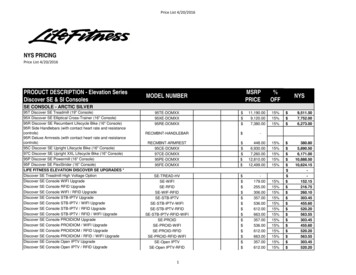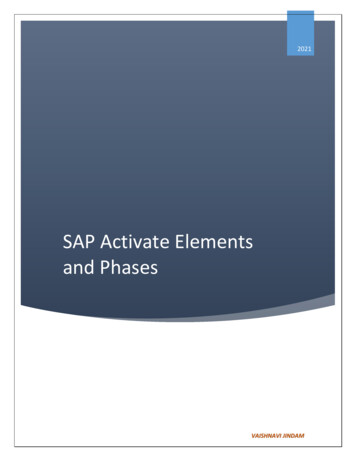
Transcription
2021SAP Activate Elementsand PhasesVAISHNAVI JINDAM
1ContentsEvolution of SAP: . 2Benefits of SAP Activate:. 11Key Characteristics of SAP Activate . 11SAP Quality principles . 13Elements of SAP Activate: . 17Anatomy of SAP Activate Methodology Implementation Roadmap . 22Phases: . 30VAISHNAVI JINDAM
2Evolution of SAP:SAP has broken the limitations of its past via its innovation based digital core product-SAPS/4HANA. On 3rd February 2015, SAP announced its new business suite fully built on SAP HANAcalled SAP S/4HANA meaning SAP Business Suite 4 SAP HANA. This is considered to be the newproduct and biggest innovation of SAP since R/3 System.Early70’s1973197919921999,2004SAP FoundedR/1R/2R/3mySAPERP2009BusinessSuite 72015-presentS/4HANA SAP was founded by a number of ex-IBM employees in the early 1970s. Their first system wascalled RF (real-time financials), and was later re-named as R/1.A Software mainly consists of three layers — Presentation Layer, Application Layer and DatabaseLayer Provides graphical screens to users User enter data on screensPresentation Shows processed data to userlayerApplicationlayerDatabase Process data using application logic Communicate with both layers Read/Write from database Management,storage and retrieval of datalayerSAP R/1 system:SAP R/1 is the first ever product of the Software Giant — SAP stands for Systems, Applicationsand Products in Data Processing. As the name suggests, SAP R/1 is the system with one tierarchitecture. ‘R’ stands for real time data processing.VAISHNAVI JINDAM
3In one-tier architecture (SAP R/1), all these three layers were installed in one server. The firstmodule developed was Financial Accounting System. It was introduced in the year 1973.SAP R/2 system:SAP R/2 is the SAP’s mainframe product and also the first ever compact software package for theend-to-end business applications. It was introduced in the year 1979. SAP R/2 runs on mainframessuch as IBM, Siemens, Amdahl etc., The last version of R/2 System is 6.1.R/2 System is two-tier architecture based product. Presentation layer is on one server while theapplication and database layers are present in another server. The mainframe solution is not open.But with the help of ALE (Application Link Enabled) Technology, R/2 can be linked to system andshare online data.SAP R/3 System:SAP R/3 is SAP’s integrated software solution for client/server and distributed open systems andintroduced in 1992. SAP R/3 has many modules such as HR, Finance, MM covering all enterprise.The SAP R/3 System working process is described as follows: All requests that come in from presentation server are directed first to the dispatcher.The dispatcher writes them first to the dispatcher queue.The dispatcher pulls the requests from the queue on a first-in, first-out basis.Each request is then allocated to the first available work process. A work process handlesone process at a time.mySAP:Using the mySAP.com platform: employees, customers, suppliers, and other business partners canwork together across company borders — anytime, anywhere. The emergence of webVAISHNAVI JINDAM
4technologies and the need for ERP to be able to connect on a B2B or B2C basis via the internet,mySAP.com was used as a brandSAP ERP – ERP Central Component (ECC):In 2004, SAP launched a new version of R/3 software with a revised architecture called SAP ECC(SAP ERP Central Component). It is SAP’s ERP (Enterprise Resource Planning) solution. It is one ofthe most robust and successful ERP software.SAP ECC comprises of 10 functional components such as Financial Accounting (FI), Controlling(CO), Sales and Distribution (SD), Materials Management (MM), Production Planning (PP), QualityManagement (QM), Plan Maintenance (PM), Customer Service (CS), Project Systems (PS) andHuman Capital Management (HCM).The modules within the ECC systems are tightly integrated with each other which makes the dataflow between multiple line of businesses easy and efficient. It also provides an integrated viewof the whole organization.SAP offers mainstream support for SAP ECC until 31st December 2025. Customers have an optionto buy extended maintenance for two more years (until 2027) with an additional cost. Thesuccessor of SAP ECC is SAP S/4HANA.SAP Business Suite:During the 2000s the number of processes covered by the R/3 or ERP was continuously increased,in addition to that, a number of additional applications were launched to provide more advancedcapabilities in certain areas. SAP started to package a number of these together in the late 90sunder the name, “business suite”. The main components of business suite are:VAISHNAVI JINDAM
5SCM (supply chain management)Procurement networks, productionnetworks, distribution networks, planning,Product ideation to production.organisation and execution of supplyprocesses.ERP(enterprise resource planning)PLM (product lifecycle management)Basically the evolution of R/3 – thecore of business suite includingfinancials, human capitalmanagement, operations,corporate services etc.SRM (supplier relationship management)Procurement for materials, goods andservices. Requirements determination toordering to payment.CRM (customer relationship management)Sales, marketing, and service.SAP S/4 HANA:SAP S/4HANA is short for SAP Business Suite 4 SAP HANA. It is the latest ERP offering from SAPand is based on the SAP HANA in-memory database to help organizations execute transactionsand analyze business data in real-time. It is the fourth version of the SAP Business Suite and isdesigned to run only on SAP HANA.Three main building blocks of S/4HANA: The HANA platform (or HANA database) – a new database that solves the problemsfaced by ERP. S/4HANA (i.e. the HANA business suite) – an updated version of business suite 7taking advantage of the benefits of the HANA platform; Fiori – a new approach to UI with more focus on flexible app style development andmobile.HANA Platform:HANA stands for High Performance Analytical Application. The increases in processing power andstorage and reduction in hardware costs gave SAP the opportunity to re-think the architecture ofERP. This brings us to HANA.There are three key features that allow the HANA platform to solve the problems ERP and BIwere facing, these are: In-memory computing: SAP HANA runs on multi-core CPUs with fast communicationbetween processor cores and containing terabytes of main memory. With SAP HANA, allVAISHNAVI JINDAM
6 data is available in main memory, which avoids the performance penalty of disk I/O (i.e.read/write to auxiliary memory).Parallel processing: parallel processing, is a fairly common concept where moderncomputers can use multiple processors simultaneously on an operation.Columnar database managemnet & data compression: In addition to in-memory, HANAapplies database management methods that are much more efficient at compressingdata. And the more compressed data can be the faster the system can run.Consider the table below. Traditionally an OLTP type database will hold data in a rowstore. If you compare the row store with an alternative method; the column store, you willquickly realize that for the column store a lot of values may be duplicated side by side.Intuitively we can see a columnar store may be much easier to compress.‘in-memory’ design with ‘columnar’ store, the HANA platform provides a database that canoperate hugely faster than the database options used in R/3 or business suite 7 or any traditionalOLTP system.SAP business suite 4 HANA:The business suite present in S/4HANA is essentially an updated version of business suite 7.We could say that the conversion from say R/3 to S/4HANA is a technical upgrade from a databaseperspective. But from an application perspective, there are further changes and enhancementsmany of which are enabled by the database conversion.A big part of S/4HANA implementation is understanding which simplifications and enhancementsare available and which you would like to implement. Not all simplifications are mandatory. Andeach simplification or enhancement has its own unique impact on the process, data etc.VAISHNAVI JINDAM
7SAP provides a simplification list for each HANA release. The Simplification List describes thepotential adaptation work that is required to convert your SAP ERP system to SAP S/4HANA at afunctional level.Fiori:SAP Fiori is a new user experience (UX) for SAP software and applications and SAP has developedFiori Apps based on User interface UI5. It provides a set of applications that are used in regularbusiness functions like work approvals, financial apps, calculation apps and various self-serviceapps.SAP Fiori was really built as a single, consistent point of entry for users, that will then drive youto specific details and capabilities no matter if they're in an on-premises solution, or they're in acloud solution, or even something built by a third party.It's a role-based, personalized, and a real-time, contextual aggregation point for all apps, and allanalytics, across all solutions, and functional areas and technology.So SAP Fiori is the true realization of overall user experience strategy, and as really built to bring thesefive design principles to life.SAP Fiori design principles:Role-based: SAP has decomposed various SAP transactions and changed them into userinteractive applications that show only most relevant information to the users.Adaptive: it is able to easily adapt to different use cases, different devices, it's got to workconsistently, and in the same way, no matter where you're interacting with an SAPsolution, whether from a device, whether from a screen, or some kind of an audible basedinterface, it needs to adapt to the way that you work.Simple: it is probably one of the most difficult to achieve, because it is so easy to continue towant to add features, and capabilities, and functions to screens. And the art of simplicity aroundincluding only what is necessary has to be continuously monitored to make sure that thatcomplexity doesn't creep in.Coherent: It is intuitive, reduce user adoption challenges, and increase adoption by enablingindividual users to self-train on individual solutions.VAISHNAVI JINDAM
8Delightful: SAP Fiori was designed to work with ECC 6.0 to make it easy for the users and todeploy on the existing SAP system.Types of Fiori Apps:SAP Fiori apps are divided into three categories. They are distinguished on the basis of theirfunction and infrastructure requirement. Transactional Apps Fact sheets Analytical AppsTransactional Apps SAP Fiori Transactional Apps are used for any process that involves a transaction – forinstance an employee raises a leave request through My Leave Requests app and themanager can approve or reject the leave request through the Approve LeaveRequests app. Any transactional activity that involves creating, changing, or approving would comeunder this category and it can be deployed with any database. Transactional Apps run best on SAP HANA database but can be deployed with anydatabase with acceptable performance. These apps allow a user to run simple SAP transactions on the mobile devices as well asdesktop or laptops.Example Leave Request, Travel Request, Purchase Order.Fact sheets SAP Fiori Factsheet Apps enables users to access contextual information about specifickey information (central objects) used in business operations. A factsheet app can be accessed from another related factsheet app, or from relatedtransactional and analytical apps. A Debit Memo Request is a factsheet app that displays net value, billing status, relatedinvoices and related sales orders. Factsheets only run on a SAP HANA Database.Example There is a fact sheet app with the center objects having details about vendor contract.You can drill down to further details like vendor details, contract terms, item details, etc.VAISHNAVI JINDAM
9Analytical AppsSAP Fiori Analytical Apps convert a large volume of data into business actionable insights.These apps run with the analytical power of SAP HANA integrated along with the interfacecomponents of SAP Business Suite.They are capable of evaluating strategic KPIs in real time allowing users to react to changes inmarket conditions.SAP Fiori Analytical apps run on SAP HANA database and use Virtual data models.ECC VS S4HANAECCS4HANASAP ECC can run on third party databases such asOracle,IBM,DB2 etc.S4HANA can run only on HANA databaseGUI – configurations happen in GUIGUI, Fiori/Web browserFew configurations happen in GUI and most of itdone in FioriLow performance, reads data slowly fromdatabaseDue it’s in-memory capability, column based, ithas high performanceCan be accessed only in DesktopFiori apps can be accessed on multiple devicessuch as Desktops, mobile, tablet.Benefits of S4HANA: It has modern UI with fiori and ready to run business solution for different industries builtinto itIt has option of on-premise or cloud or hybrid (mix of on-premise and cloud) deploymentsolutionsIt natively integrates with other sap products such as Ariba, Successfactors, Fieldglass,ConcurCan connect on multiple devices such as Mobile, Desktop, tabletCan also get into social network data and use it for analysisHANA enables in-memory computing. This enables the data to be read directly from thememory. This means that data always resides in the main memory RAM even throughwrite operations happen in the hard disk. Therefore, SAP S/4HANA reads data much fasterthan traditional ERPs since the HANA database reads data much faster than traditionaldatabases.VAISHNAVI JINDAM
10 SAP S/4HANA can access column-based tables faster since only affected columns are readin a querySAP S/4HANA enables better compression since there only few distinct values comparedto rows.SAP S/4HANA enables parallel processing since different columns can be processedparallelly.With SAP S/4HANA powered by SAP HANA, Online Transactional Processing (OLTP) andOnline Analytical Processing (OLAP) can happen in the same system. This enables realtime reporting and predictive analysis.SAP S/4HANA will not have aggregates, index, or history tables. This is because aggregatesare created dynamically based on line item tables instantaneously.VAISHNAVI JINDAM
11SAP ActivateSAP has launched guideline framework called SAP Activate to move/migrate legacy system to S4Hana or deploy a new S4 Hana system.Benefits of SAP Activate:It reduces the time and cost attached to S4 Hana migration on deployment projectIt reduces the risk while mobbing forward as it follows agile approach where in solutiongets deployed on iteration (incremental delivery) which makes customer morecomfortable with new system because they get see the iterations of same product andget used to it It gives the flexibility to deploy the solution in on premise or cloud edition or Hybrid (onpremise and Cloud) where in earlier we have only on premise option in ASAP.Cloud: Cloud is hosted externally on SAP’s servers and maintained by SAP. You can choosevendors such as Hana Enterprise Cloud (HEC) provided by SAP or AZURE or AWS or Google cloudservices and use it to upgrade your system to S4 Hana system. It has a quarterly innovation cycle.On-premise: It is hosted on your organizations own servers and managed in-house. If youwant the software in your premise and have full control of it. It has an annual innovation cyclewith several smaller updates each year.Hybrid: Mix of Cloud and On-premise Key Characteristics of SAP ActivateBased on Ready-to-UseContentUse business process BestPractices and AcceleratorsCloud ReadyLeverage the flexibility andSpeed of the cloudDelta BasedValidate Solution based onSandbox and capture deltaScalable, Modular and AgileStructure Project to deliver thesolution incrementally usingscrumSAP Engagement ReadyEmpower project team withvendor knowledgeQuality Built-InUse Quality Gates to driveacceptanceVAISHNAVI JINDAM
12Start with best practices: Use Ready-to-Run business processesFast Time to Value: Get a jump start for implementations with SAP Best Practices. Deployinnovations fast, simply and with flexibilityPredictable results: Use SAP’s tested and proven methodology with prescriptiveguidelines, Leverage preconfigured business contentSimple On-boarding to cloud: Protect your on premise investments with extensions to thecloud, Move up on the path to the cloud from pre-assembled trials to productive useCloud-ready: Leverage the flexibility and speed of cloud. You can get preconfigured solutionmanager from SAP when you are working with cloud solution and can get fully activatedappliances like STE/MTE in the cloud. You can have Model Company downloaded into yoursystem and wants to check how your industries model look like. You can get free trails from SAP,you just have to host on one of the cloud like AWS, AZURE etc. and directly can use it. Multipledeployment options such as On-premise, Cloud and Hybrid are available.Validate solution instead of blueprinting(Delta-Based) Validate best practices with fit/gapworkshop and capture data. You set the reference system/baseline value for the sandbox system,make it available. Then you validate the system whether it’s working fine or not and you collectthe delta requirement that is what the business wants and what is there in your sandbox so youwork with business to identify the gaps in your system which are expected out of the final systemwhich you will be building. Out of this exercise, you will be able to create a backlog list where youwill mention all the gaps which you have in the system and which needs to be fulfilled. From that,you will enhance the solution document, overall design and how it should be with all the inputsyou got from the collection of delta requirement and creating a backlog list. Once it is updatedyou will get it verified within your team and then with business as well. So you need a signofffrom the business that is a solution document which we are going to implement in s4hana, whichis a new system. Once sol doc is verified and accepted by business then you go head and startsprints which project is planning for future release.Premium engagement ready: Build and run fully supported via SAP control centers.Premium engagement ready is a service provided by SAP to its customer and partner where theywill come to your place and they will work with your team to help you innovate and streamlinethe whole process of building and runSAP create innovation control center (ICC) along with project team, set some ground rules andbasic idea is to run the build phase as a factory, as an assembly line so it is more optimized,innovative and effective, then operational control center (OCC) with project team will run theoperation part as a factory which will help you managing the whole SAP landscape in supportmore effectively.Innovation control center (ICC): is the show room for prototypes and new businessmodels/processesVAISHNAVI JINDAM
13Operational control center (OCC): is the show room for business process operations as well assystem operationsMission Control center (MCC) is overall controlling body of ICC and OCC and will have access toyour system with your business as well and it support both control centerModular, scalable, and agile: Structured project to deliver solution directly.Deployment options: SAP Activate provides you with multiple deployment options andtools which are required for various deployment optionsFunctional Coverage: We can create minimum viable project (MVP) of product, release it,take the feedback from users and enhance it as you go further and keep on adding newfeatures in iterative mode with business. Uses scrum based approach to build solutionsFlexible Team Size: SAP activate accommodates small team and big team depends onprojectsAvailability of Expertise: SAP experts are available to help you when you need and bygetting premium engagement you can take help.Support: it has framework as support, you can have a SAP SLA management reporting andtoolsWe can use solution manager to manage multiple projectsQuality built-in: Identify the risks early with a total quality approach.The project quality gate process is a formal way of specifying and recording the transitionbetween critical stages in the project lifecycleEach project quality gate verifies that acceptance is meet for the deliverables required andactions to be completed for the associated critical stageThe project quality gate plan is defined in the Project Management PlanSAP Quality principlesWhen implementing IT solutions to drive business transformation, an organization mustunderstand what it takes to complete the project successfully, whether the project is large orsmall, whether implemented on premise or in the cloud.Achieving extraordinary business transformation through the implementation of an IT solutionisn’t a matter of luck. It requires careful planning and a commitment to 10 principles of quality.By applying these 10 principles, you establish predictability and transparency in your project,whether you are intending to implement on premise or cloud solutions.Link to go through 10 SAP Quality Principles: 10 SAP Quality PrinciplesVAISHNAVI JINDAM
141. Anchor business value in the project2. Start Scoping early3. Cooperate with stakeholders and use a proper governance model4. Ensure timely delivery and effective tracking5. Staff the project with sufficient, competent and motivated people6. Apply appropriate methodology and plan for quality7. Identify and manage risks and issues throughout the project8. Exploit standard functionality and delivery best practices9. Achieve production readiness10. Use organizational change management to transform businessWatch any/quality/awards/principles.html1. Anchor business value in the projectThroughout a project, numerous design and implementation decisions are made. To makeappropriate and effective decisions, all involved parties must fully understand the project’sstrategic importance, its business objectives, and its key success criteria. These aspects shouldbe tracked not only throughout the project but after going live with the software as well to makesure the solution meets the business requirements.This tracking also helps determine whether changes proposed to the project scope – whether bigor small – are justified by the business value they may add. The business case for the investmentshould be clearly understood by implementation partners. Partners should be selected based ontheir proven ability to deliver on every aspect of the project from both a technical and businessperspective.2. Start scoping earlyTechnical requirements must be determined early on in order to implement a feasible,affordable, maintainable environment that delivers adequately. To do this effectively, theapplication landscape and system architecture must be aligned with the business strategy.Preexisting assumptions should be reassessed periodically once the project has been started inorder to monitor their impact on the project. Relevant requirements regarding master data, dataflow, integration, security, interfaces, and legacy environments must be analyzed early to allowfor sufficient time to plan the related efforts. Involve business users early on when collectingprocess and functional requirements. This helps ensure buy-in to the final solutionVAISHNAVI JINDAM
153. Cooperate with Stakeholders and Use a Proper Governance ModelProject team members and stakeholders must thoroughly understand the project’s scope andfocus on achieving its business objectives and operational drivers. To do this, A project chartermust be shared at the beginning of the project to align stakeholders and facilitate the onboardingof the initial team as well as resources added later on.Roles and responsibilities must be defined in the initial engagement phase so everyone involvedunderstands the team structure, lines of communication, and who has the authority to makewhich decisions. Formal reporting, regular meetings of the steering committee, rapid escalationmechanisms, and a project team empowered to make the necessary decisions in a timely mannerare instrumental in achieving project success. A strong executive project sponsor should assumeresponsibility for the success of the project from start to finish and clearly emphasize the successcriteria and reasons for and benefits of the chosen solution. Audits at key milestones canascertain the degree of compliance from both a business and regulatory perspective.Communication must be clear and transparent throughout the implementation, internally andwith subcontractors, partners, and other stakeholders4. Ensure Timely Delivery and Effective TrackingAgree on scope and ascertain that the resources available and timeline are sufficient to completethe deliverables at the agreed-on level of quality All parties must sign off on the timeline,deliverables, and acceptance criteria and be aware of the pace required in order to avoidimpacting the overall timeline. Any subsequent adjustments made to project scope or timelinemust be considered first in light of business impact and second as to whether they are realistic,relevant, and acceptable. Activities and tools must be in place to monitor time, budget, anddeliverables. Key performance indicators for the project should be tracked closely and be visibleto all stakeholders5. Staff Project with Sufficient, Competent, Motivated PeopleCarefully recruit your project staff and select a partner who will provide you with the right mix ofskills and experience. Train team members early so they understand the technical and functionalcontext in which they are working, what design possibilities are open to them in that context,and the impact of their decisions. Throughout the implementation, the skills and competenciesof the implementation team members should be reviewed regularly to verify that they continueto meet project requirements. Their commitment and time allocation should be assessedregularly and addressed when inadequate. Also, team engagement and motivation should beassessed and revitalized on a regular basis, with special attention given to members workingremotely. Team members should be made aware of how their role in the current project cancontribute to the advancement of their careers.VAISHNAVI JINDAM
166. Apply Appropriate Methodology and Plan for QualityMethodologies and guidelines must be agreed on. A proven implementation methodologycontributes significantly to project success, but it must be suitable for the specific project and itssolution scope. A methodology backed by industry recognized project management training andcertification increases the degree of professionalism and efficiency with which theimplementation is managed. Everyone must work according to the same quality standards andunderstand the review methods and criteria to be used to measure the quality of projectdeliverables. If a project is critical or larger in scope, a dedicated quality manager role may becreated. A quality plan can serve as a neutral framework for helping ensure that quality is builtinto a project from the very start as well as for evaluating the deliverables against the agreed-onstandards. In later stages of the project, during rollouts, and in future implementation projects,it can be used to leverage lessons learned.7. Identify and Manage Risks and Issues throughout the ProjectCareful identification, analysis, and management of risks and issues are key to success. Regardlessof project size, a formal risk management process should be followed and include organizationsaffected by the implementation as well as implementation partners. Revisit risks on a regularbasis throughout the project lifecycle, and consider third-party input at important junctions.Support the process with an effective governance policy, and prepare all parties to acknowledgerisks honestly. Enlist their commitment in recommending pragmatic, rigorous mitigation actionsand their readiness to implement those recommendations.8. Exploit Standard Functionality and Delivery Best PracticesSoftware configuration is often very powerful, versatile, and far reaching. Through configurationalone, or through the use of solution templates, seemingly unique business requirements can befulfilled, making major software modifications unnecessary. The result is the faster delivery of amore sustainable solution, at lower risk and at lower total cost of ownership in the long term. Toput this into practice, all parties must be aware of what the standard software offers and itsstrength to facilitate process alignment. They must also be committed to leveraging standardsoftware and must raise a flag when it is not used when it could be. An objective third partyshould carry out quality assurance at key project milestones to make sure best practices are beingfollowed and to help avoid developing unnecessary custom code or workarounds or gettingcaught in “scope creep.”9. Achieve Production ReadinessAn appropriate application lifecycle management approach must be planned early so it is readywhe
A factsheet app can be accessed from related factsheet app, or from related another transactional and analytical apps. A Debit Memo Request is a factsheet app that displays net value, billing status, related invoices and related sales orde




